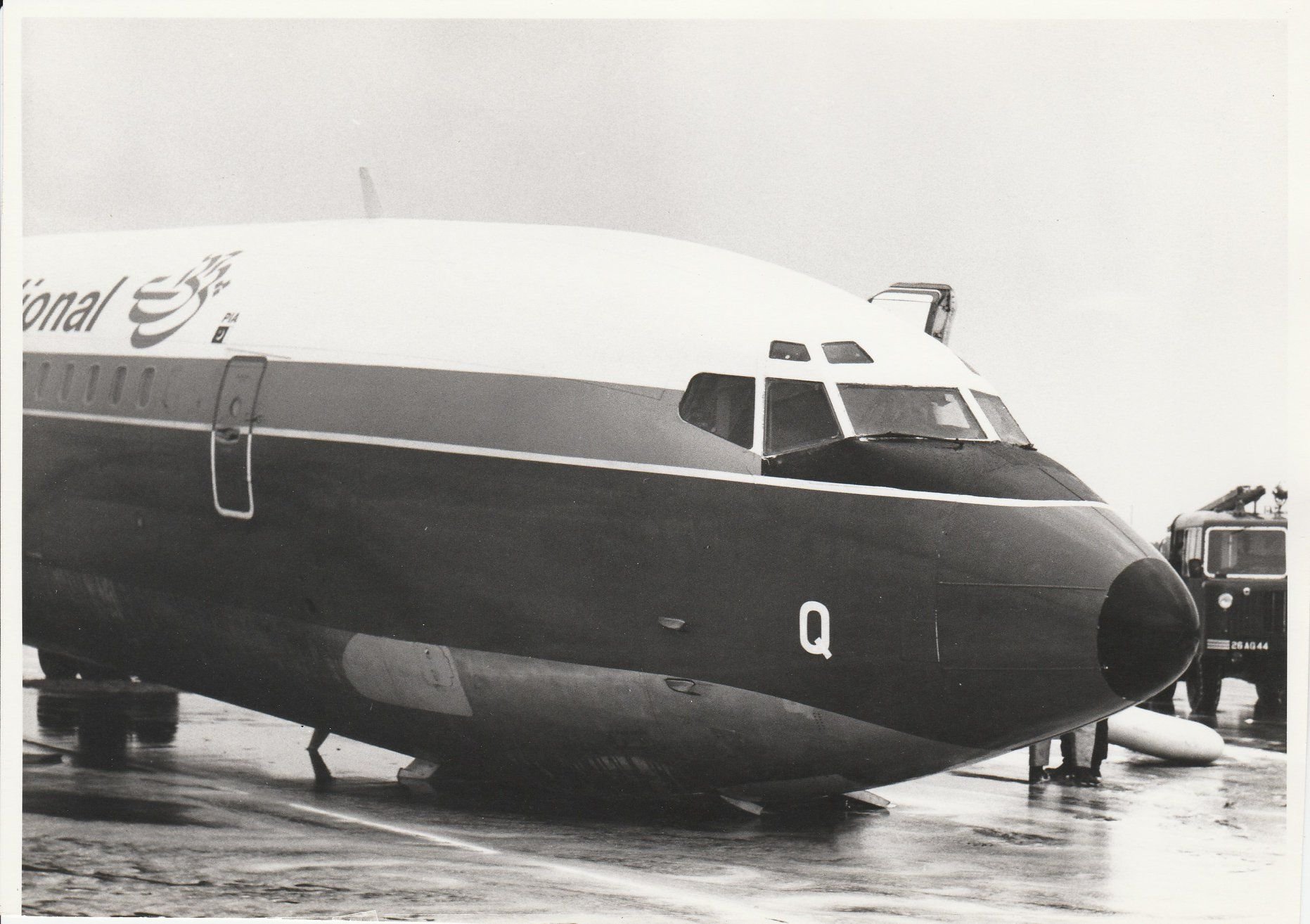PIA A320 Crash Karachi
Join Date: Jul 2006
Location: Somewhere over the rainbow
Posts: 946
Likes: 0
Received 0 Likes
on
0 Posts
Even with a loud warning like in this video, if you are distracted for any reason it can still happen.
But I also believe it most probably happens during a baulked landing.
Last edited by pineteam; 23rd May 2020 at 17:42. Reason: Typo
Join Date: Sep 2019
Location: Transient
Posts: 9
Likes: 0
Received 0 Likes
on
0 Posts
"Unfortunately, this may prove to be another example of a super dangerous ex military jockey pushing things to the limit"
Or just generally incompetent crew regardless of background.
Or just generally incompetent crew regardless of background.
Join Date: Dec 2001
Location: Malta
Posts: 177
Likes: 0
Received 0 Likes
on
0 Posts


Something with PIA and landing gears. Boeing 720 was a base training mishap ~1975 (no injuries/Aircraft returned to service). whilst in the 747-200 accident in1986 crew forgot to lower landing gear before landing. The aircraft made belly landing. Passengers and crew were evacuated through emergency escape slides. Some of the passengers received minor injuries during the evacuation process. Two engines of the aircraft were damaged beyond repair due to belly landing. The Boeing 747 returned to service after repair work.
Join Date: Mar 2015
Location: North by Northwest
Posts: 476
Likes: 0
Received 0 Likes
on
0 Posts
Avherald now reporting the following:
"On May 23rd 2020 Karachi Airport reported based on CAA inspection report that the runway inspection revealed scrape marks of the left engine start 4500 feet down the runway, the right engine scrape marks begin 5500 feet down the runway. About 6000-7000 feet past the runway threshold the scrape marks end."
"On May 23rd 2020 Karachi Airport reported based on CAA inspection report that the runway inspection revealed scrape marks of the left engine start 4500 feet down the runway, the right engine scrape marks begin 5500 feet down the runway. About 6000-7000 feet past the runway threshold the scrape marks end."
Join Date: Mar 2011
Location: London
Age: 44
Posts: 41
Likes: 0
Received 0 Likes
on
0 Posts
Its not like all black carbon fibre on an F1 car
Join Date: Sep 2007
Location: Slough, UK
Age: 35
Posts: 281
Likes: 0
Received 0 Likes
on
0 Posts
I don’t think I’ve seen it mentioned but my theory is possibly a false glideslope capture similar to the MyCargo 747 at Bishkek. That’s backed up by listening to the recordings when one of the pilots says “we can make it” which suggests the aircraft has nearly acquired the G/S ‘diamond’ (whilst forgetting to check to see if it’s a sensible glideslope indication using the 3x table). The controller clearly doesn’t feel comfortable as he reiterates they’re 3000-3500ft at 5nm but the pilots reply they’re established on the ILS.
They’d then become so task saturated trying to slow the aircraft down to Vapp that they’d develop tunnel vision and selective hearing, therefore both crew members completely fail to notice the overspeed klaxon sounding in the background plus the inevitable TOO LOW GEAR.
Then as others have said, a little float down the runway, a late decision to go around when they realise the gear isn’t down (or they’re running out of runway) and the engines then take time to spool up. This would then cause the engines to scrape the runway momentarily damaging fuel and oil lines. The engines would probably develop some or TOGA power initially allowing the aircraft to climb out but they then destroy themselves if the internal mechanisms have been damaged (or simply run out of fuel or operate at a limited power). The crew then attempt a tight circuit, lower the gear which drastically reduces the L/D ratio and the aircraft stalls into the urban area just short of the airport. It’s likely at this point the aircraft was probably in alternate law depending on what was damaged reverting to direct law when the gear goes down. This is a much higher workload situation requiring manual trim and a different feel in both pitch and roll and also doesn’t offer the same protections as normal or alternate law.
Causal factors include a lack of sense checking as to their current position in relation to the airfield and both pilots being a bit rusty due to a lack of flying because of COVID. This then lead to a high energy state. They may have been offered various shortcuts by ATC as well due to vastly reduced traffic levels which only exacerbated the situation. Then tunnel vision, selective hearing and a breakdown in CRM occur as both pilots go from a benign scenario in the initial descent to being totally overloaded in a short space of time but suffering from ‘get-thereitis’.
As I said, it’s all pure speculation but this would fit in with what I’ve read so far. What I can’t understand is why the flaps are retracted. Possibly the engines only quit as the aircraft had just cleaned up passing the acceleration altitude.
They’d then become so task saturated trying to slow the aircraft down to Vapp that they’d develop tunnel vision and selective hearing, therefore both crew members completely fail to notice the overspeed klaxon sounding in the background plus the inevitable TOO LOW GEAR.
Then as others have said, a little float down the runway, a late decision to go around when they realise the gear isn’t down (or they’re running out of runway) and the engines then take time to spool up. This would then cause the engines to scrape the runway momentarily damaging fuel and oil lines. The engines would probably develop some or TOGA power initially allowing the aircraft to climb out but they then destroy themselves if the internal mechanisms have been damaged (or simply run out of fuel or operate at a limited power). The crew then attempt a tight circuit, lower the gear which drastically reduces the L/D ratio and the aircraft stalls into the urban area just short of the airport. It’s likely at this point the aircraft was probably in alternate law depending on what was damaged reverting to direct law when the gear goes down. This is a much higher workload situation requiring manual trim and a different feel in both pitch and roll and also doesn’t offer the same protections as normal or alternate law.
Causal factors include a lack of sense checking as to their current position in relation to the airfield and both pilots being a bit rusty due to a lack of flying because of COVID. This then lead to a high energy state. They may have been offered various shortcuts by ATC as well due to vastly reduced traffic levels which only exacerbated the situation. Then tunnel vision, selective hearing and a breakdown in CRM occur as both pilots go from a benign scenario in the initial descent to being totally overloaded in a short space of time but suffering from ‘get-thereitis’.
As I said, it’s all pure speculation but this would fit in with what I’ve read so far. What I can’t understand is why the flaps are retracted. Possibly the engines only quit as the aircraft had just cleaned up passing the acceleration altitude.
Join Date: May 2005
Location: uk
Posts: 573
Likes: 0
Received 0 Likes
on
0 Posts
Soon we will find out whether the landing gear was lowered at all on the first approach. That will be key in understanding the rest. Options are:
1. Gear was never selected down on the 1st approach
2. Gear was selected down on the 1st approach but a go around was initiated before touchdown with a premature gear up selection
3 Gear was selected down on the 1st approach but a go around was initiated after touchdown/bounce with a premature gear up selection
1. Gear was never selected down on the 1st approach
2. Gear was selected down on the 1st approach but a go around was initiated before touchdown with a premature gear up selection
3 Gear was selected down on the 1st approach but a go around was initiated after touchdown/bounce with a premature gear up selection
Join Date: May 2020
Location: PA
Posts: 10
Likes: 0
Received 0 Likes
on
0 Posts
Join Date: Mar 2012
Location: Having a margarita on the beach
Posts: 2,423
Likes: 0
Received 0 Likes
on
0 Posts
Yes, but if my interpretation of the picture is correct then the gear may have been down, and was in the process of retracting when ground contact was made.
(It could also have been on its way down, but that's most unlikely).
I'd been puzzled by the gear up pictures because the captions 'seconds before crash' implies that it was taken on approach. I suggest that it was 'minutes before' and that they were taken as it climbed away from the first attempt.
(It could also have been on its way down, but that's most unlikely).
I'd been puzzled by the gear up pictures because the captions 'seconds before crash' implies that it was taken on approach. I suggest that it was 'minutes before' and that they were taken as it climbed away from the first attempt.
Join Date: Jan 2013
Location: Earth
Posts: 29
Likes: 0
Received 0 Likes
on
0 Posts
See here for comparison:
https://qph.fs.quoracdn.net/main-qim...6473d8aaad51-c
Join Date: Oct 2019
Location: Great White North of the 49th
Posts: 77
Likes: 0
Received 0 Likes
on
0 Posts
Regardless of the gear situation and short of catastrophic failure, I still can’t fathom any attempt at landing when your high and hot at 5nm final! 3500’ at 5nm is almost double altitude so my brain is already in GA mode. If the aeroplane was that out of sorts you land on first attempt even if it’s belly first. Lots of real head scratchers here. That aeroplane got way ahead of those boys. How that happened remains to be seen but it’s bloody tragedy.
Join Date: Sep 2014
Location: UK
Posts: 98
Likes: 0
Received 0 Likes
on
0 Posts
Join Date: Mar 2011
Location: London
Age: 44
Posts: 41
Likes: 0
Received 0 Likes
on
0 Posts
Join Date: May 1999
Location: UK
Posts: 157
Likes: 0
Received 0 Likes
on
0 Posts
Just to clarify, people are talking about a master caution for the gear not being down.
The warning is a repetitive “TOO LOW, GEAR” in a loud, urgent voice over the speakers. IIRC it triggers at 500RA, it’s hard to believe they continued to land with that happening. You can’t cancel it unless you turn the GPWS off on the overhead panel.
A mishandled baulked landing after a high energy approach and deep landing is much more likely.
Very sad.
The warning is a repetitive “TOO LOW, GEAR” in a loud, urgent voice over the speakers. IIRC it triggers at 500RA, it’s hard to believe they continued to land with that happening. You can’t cancel it unless you turn the GPWS off on the overhead panel.
A mishandled baulked landing after a high energy approach and deep landing is much more likely.
Very sad.
Triggering conditions.
- L/G is not downlocked and radio height is lower than 750 ft and both engines N1 lower than 75% (or if engine shutdown N1of remaining engine lower than 97%) or
- L/G is not downlocked and radio height is lower than 750 ft and both engines are not at T.O power and flaps at 1, 2, 3 or FULL or
- L/G is not downlocked and flaps at 3 or FULL and both radio altimeters are failed.
A useful reference other than the FCOM.
https://safetyfirst.airbus.com/app/t...r-downlock.pdf
Last edited by Down Three Greens; 23rd May 2020 at 19:54.



